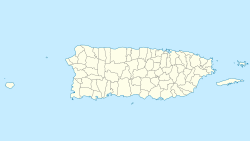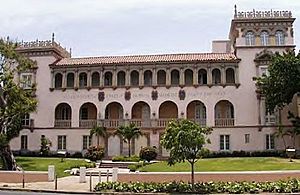School of Tropical Medicine (Puerto Rico) facts for kids
|
School of Tropical Medicine
|
|
|
U.S. Historic district
Contributing property |
|

School of Tropical Medicine - Univ. of Puerto Rico
|
|
| Location | Ponce de León Ave, Barrio Puerto de Tierra, San Juan, Puerto Rico |
|---|---|
| Area | 3.9 acres (1.6 ha) |
| Built | 1926 |
| Architect | Rafael Carmoega |
| Architectural style | Neo-Plateresque |
| Part of | Puerta de Tierra Historic District (ID100002936) |
| NRHP reference No. | 83002297 |
Quick facts for kids Significant dates |
|
| Added to NRHP | September 29, 1983 |
| Designated CP | October 15, 2019 |
The School of Tropical Medicine (also known as the Escuela de Medicina Tropical in Spanish) was a special school in Puerto Rico. It was started in 1926 to study diseases common in tropical places, especially anemia. Before this school, groups like the Anemia Commissions and the Institute of Tropical Medicine had already started this important research.
The school worked on its own until 1949. Then, it became part of the School of Medicine at the University of Puerto Rico.
Contents
History
Early Research: The Anemia Commission
Captain Bailey K. Ashford was a doctor in the United States Army. He came to Puerto Rico in 1898 during the Spanish–American War. While working in a hospital in Ponce, he made an important discovery. He was the first to find and successfully treat hookworm in North America in 1899.
Hookworm is a type of parasite that can cause anemia, which means your blood doesn't have enough healthy red cells. Captain Ashford's research showed that hookworm was a major cause of anemia in Puerto Rico. He was inspired to start a campaign to treat people.
This campaign helped about 300,000 people, which was one-third of Puerto Rico's population at the time. It also reduced the number of deaths from this type of anemia by 90 percent.
Captain Ashford and Dr. Isaac González Martínez encouraged the government to start a program to fight hookworm and anemia. In 1904, they became the first members of the Puerto Rico Anemia Commission. This commission was the beginning of medical research in Puerto Rico.
In 1911, Ashford, along with doctors Isaac González Martínez, Pedro Gutiérrez Igaravides, and Walter King, suggested creating an Institute of Tropical Medicine. This institute would continue the important research started by the Anemia Commissions. The local government approved this idea in 1912, and the Institute of Tropical Medicine was established.
Founding the School of Tropical Medicine
In 1924, Antonio R. Barceló, who was the President of the Puerto Rico Senate, met with professors from Columbia University's Medical School. They talked about the need for a medical school in Puerto Rico. This new school would focus on studying tropical diseases.
Senator Barceló liked the idea. On June 23, 1924, he helped pass a law that gave money to Governor Horace Towner to start the school.
The School of Tropical Medicine officially opened in 1925. It was only the second school in the United States and its territories to focus on tropical diseases. The first was Tulane's School of Tropical Medicine, founded in 1913. The school's building is in Puerta de Tierra, San Juan. It is a beautiful example of the Neo-Plateresque architectural style.
In 1926, new laws expanded the Institute of Tropical Medicine into the School of Tropical Medicine of the University of Puerto Rico. It was run with the help of Columbia University. Both universities made an agreement about how to manage the school's money.
After a 30-year career in the Army, Captain Ashford became a full-time professor at the school. He continued his important work on tropical medicine. He worked with doctors Isaac González Martínez and Ramón M. Suárez Calderon to keep studying anemia.
Dr. González Martínez did many studies on parasitology (the study of parasites), bilharzia (a parasitic disease), leprosy, and typhoid fever. He also started a scientific journal called Anales de Medicina de Puerto Rico. In 1917, he was chosen as the president of the Medical Academy of Puerto Rico.
Dr. Suárez Calderon found effective ways to treat a type of anemia called tropical sprue. He also used advanced methods like electrocardiography (to study the heart) and radioisotope (using radioactive materials for medical tests) in clinics. He also helped identify and treat the disease that causes heart rheumatism. After Captain Ashford passed away, Dr. Suárez Calderon continued his research on anemia. In 1938, he published his findings on tropical sprue.
In 1927, the school offered courses in tropical medicine and nutrition. Many students went on to do more advanced studies at Columbia University. By May 1930, the University of Puerto Rico started offering Master of Arts degrees to students who studied and worked at the School of Tropical Medicine.
In 1931, doctors William B. Castle and Cornelius P. Rhoads studied hookworm and tropical sprue, and how they related to anemia. They found that liver extract could help some patients. Dr. George C. Payne also continued to study anemia in 1936 and 1937.
Becoming the UPR School of Medicine
The agreement between the University of Puerto Rico and Columbia University for the School of Tropical Medicine ended in 1948.
In May 1949, the Puerto Rican government allowed the creation of the School of Medicine of the University of Puerto Rico, also known as the UPR School of Medicine. The School of Tropical Medicine became part of this new school. The first class of students was admitted in August 1950.
On September 29, 1983, the building where the School of Tropical Medicine was located was added to the National Register of Historic Places. It was later added to the Puerto Rico Register of Historic Sites and Zones in 2000.
See also
 In Spanish: Escuela de Medicina Tropical (Puerto Rico) para niños
In Spanish: Escuela de Medicina Tropical (Puerto Rico) para niños
- National Register of Historic Places listings in San Juan, Puerto Rico
- University of Puerto Rico
- University of Puerto Rico, Medical Sciences Campus



